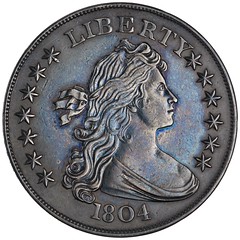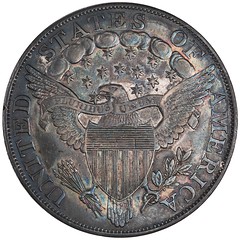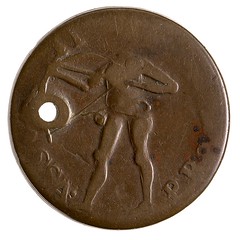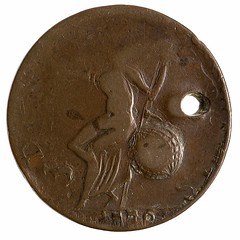
PREV ARTICLE
NEXT ARTICLE
FULL ISSUE
PREV FULL ISSUE
THE 1914 MILLION-DOLLAR ANS COIN EXHIBITAmerican Numismatic Society librarian David Hill published a nice article on the fabled 1914 ANS exhibit in the 2018 Issue 3 of ANS Magazine. With permission, here's an excerpt describing some of the highlights of the exhibit. See the complete article for the story of how dealer Henry Chapman stirred up trouble trying to settle a beef with one of his customers. -Editor The Million Dollar Exhibition of 1914 and the Time Henry Chapman Almost Got Kicked out of the ANS They called it the Million Dollar Exhibition—well, at least that's what big-time numismatic showman Farran Zerbe said they called it, this eye-popping assemblage of numismatic delights put together by the ANS in 1914. It was an overview of United States coinage, illustrated by some of the choicest examples and arranged to coincide with the Society's 56th annual meeting. The show had been announced a year earlier, as the ANS reveled in the glorious success of its Joan of Arc exhibition, an event warmly covered in the press that had brought nearly 9,000 visitors uptown to see it. The Society contributed a few items for the 1914 display, but private collectors were responsible for most of it (though a few of the delicacies on view would eventually come to rest in the Society's cabinet). As the show was set to wrap up that February, ANS officers and staff were likely feeling the satisfied tingle of another job well done—at least until Henry Chapman showed up looking to settle an old score against one of the other exhibitors. In all, twenty-seven collectors had loaned their coins. In addition to the well-known dealer Chapman, these included numismatic author and future U.S. treasury secretary William Woodin and his famous patterns; the German-born Carl Wurtzbach of Massachusetts, with his colonials, Washingtons, early patterns, and large cents; and Judson Brenner of Ohio, who lent 450 minor patterns, as well as an original Confederate cent and its dies. Zerbe's contribution was error coins—or “freaks,” as they were known—and some mistrikes. Major highlights came courtesy of James Ellsworth, the wealthy coal mine owner (and father of polar explorer Lincoln Ellsworth). Along with a Brasher doubloon (the Stickney specimen), he lent his four unique silver nova constellatio patterns, fascinating artifacts of a proposed Confederation-era coinage struck in the denominations of mark, quint, and cent (or bit).   Figure 2 And then there were the 1804 dollars. Today, visitors to the Smithsonian's Gallery of Numismatics can pull out a drawer and behold three of the 15 known specimens of this rarity. This exhibit went one better by presenting four of them, two of which were Ellsworth's. One of these Ellsworth specimens eventually found its way into the ANS cabinet (fig. 2). After Ellsworth had parted with the coin, it changed hands a few more times, eventually coming to rest with Zerbe, who in the 1920s added it to his Money of the World exhibition, a traveling road show, mostly set up in bank lobbies, that would eventually settle down in New York City as the Chase Bank Money Museum. When the museum closed in 1978, most of the collection was transferred to the Smithsonian, but the 1804 dollar and some other pieces were given to the ANS. The ANS's 1804 dollar is the Rosenthal specimen. (The catalog for the 1914 show has it as “Rosenberg,” a mistake repeated in the Numismatist review of the exhibit. Howland Wood was still referring to it as “Rosenberg” 10 years later.) The Rosenthals, Philadelphia scrap metal dealers, had acquired the coin from a business associate, W. Julius Driefus, who had supposedly gotten it from a former slave (though that part of the story doesn't really withstand serious scrutiny). Isaac Rosenthal is always identified as the owner of the coin, since he handled the transactions, but when discussing its ownership in a letter to Ellsworth (fig. 3), he says “we”—meaning him and his brothers Henry and Archibald—and he signs off with the company name, Jos. Rosenthal's Sons, all suggesting the coin was owned collectively. Isaac had written to Ellsworth to persuade him to keep the details of the transaction a secret. “We wish you would not tell anybody what you paid us for the 1804 dollar,” he said, “as we could have sold it for a good deal more money.” It must have gone for less than $1,000, since he told Ellsworth that at that amount “we could have sold it twenty times… and can get you now that price.”   Figure 4 A colonial Massachusetts pattern was another of the displayed rarities (in fact it is unique) later acquired by the ANS (fig. 4). Its existence was first announced by soon- to-be-ANS-curator Howland Wood in the Numismatist in 1911. It has an American Indian on the obverse and Liberty on the reverse and was overstruck on a 1747 George II halfpenny. Some of the features of the original coin are still visible, including the BERN in HIBERNIA, the II of George II, and the outline of the king's head. This and two other stylistically similar patterns are said to have been the work of Paul Revere. Wood donated the coin to the ANS in 1917. Fig. 2: United States. AR dollar, 1804. (ANS 1980.66.1, gift of Chase Manhattan Bank of North America). The ANS's 1804 dollar is the “Driefus-Rosenthal Specimen.” Fig. 4: Massachusetts. AE 1/2 penny, attributed to Paul Revere. (ANS 1917.136.2, gift of Howland Wood), 27 mm. For more information on the American Numismatic Society, see: Wayne Homren, Editor The Numismatic Bibliomania Society is a non-profit organization promoting numismatic literature. See our web site at coinbooks.org. To submit items for publication in The E-Sylum, write to the Editor at this address: whomren@gmail.com To subscribe go to: https://my.binhost.com/lists/listinfo/esylum All Rights Reserved. NBS Home Page Contact the NBS webmaster 
|